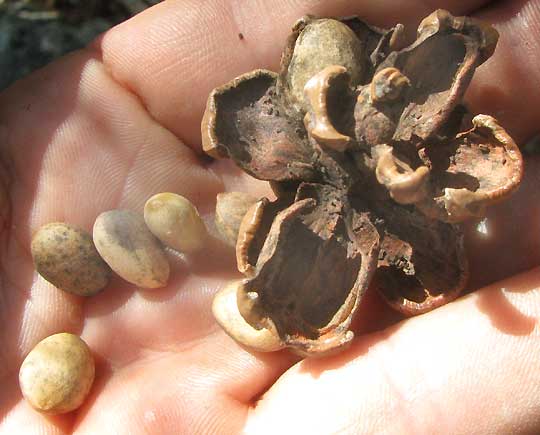Excerpts from Jim Conrad's
Naturalist Newsletter

from the October 6, 2013 Newsletter issued from the Frio Canyon Nature Education Center in the valley of the Dry Frio River in northern Uvalde County, southwestern Texas, on the southern border of the Edwards Plateau; elevation ~1750m (~5750 ft); N29.62°, W99.86°; USA
TEXAS PINYON PINE
For me, one of the greatest botanical surprises of this area has been the occurrence of what's called the Texas Pinyon Pine, PINUS REMOTA, atop a few -- but not many -- hills in the area. This week our neighbor Dave invited us on a wandering among the hills of his ranch, where pines graced the occasional hilltop. Above, you can see a branch with needles mostly grouped two per bunch, and only about 1½ inch long (4cm), along with small, ±spherical cones.
An open cone with several distinctively oval and relatively large seeds collected from the ground is shown below:

If you're familiar with pine seeds, you know that most pine species produce small, "winged" seeds -- the wings being papery, sail-like appendages helping disperse the seeds by wind. The pinyon pine's wingless, large seeds, compared to seeds of the vast majority of pine species, are simply mind boggling. You can compare the seeds in the picture with the winged seeds of a Loblolly Pine back in Mississippi at http://www.backyardnature.nec/n/w/loblolly.htm.
In that picture the seeds are hardly visible, slender bulges at the bottoms of the three large, pale wings at the left of the cone.
I first heard about pines in this area when I read La Relación by Álvar Núñez Cabeza de Vaca, one of a few Spanish survivors of a 1527 shipwreck off the coast of Florida. For eight years the survivors wandered across the future southern US and northern Mexico, becoming the first modern Europeans to see most of that area. Their precise route isn't known, but when they walked westward from the Texas Gulf coast they eventually came to hills -- our hills of the southern Edwards Plateau -- and the wanderers were very happy that pine trees there produced highly edible and nutritious seeds, with thin, easy-to-crack shells.
Texas Pinyon Pines occur only in southwestern Texas and adjacent northeastern Mexico. That is, they occur there IF you regard them as a distinct species. The online Flora of North America, which normally I use as the ultimate source for plant names, considers Texas Pinyon Pines, Pinus remota, as only a regional variation of the much wider-distributed Pinus cembroides, known as the Pinyon or Mexican Pinyon Pine, occurring at higher elevations as far south as the belt of volcanoes crossing south-central Mexico. Some authors also regard Texas Pinyons as a recognizable variety of Pinus cembroides.
Main field marks distinguishing Texas Pinyons from regular Pinyons are their thinner seed shells and the size and shape of the spine on the cone bract -- fairly obscure features. It's hard to disagree with the Flora of North America opinion that "The strong overlap in nearly all character states between the populations of the Edwards Plateau and other populations makes var. remota difficult to maintain." However, the Flora says that the regular Pinyon, Pinus cembroides, has needles mostly in groups of three, only sometimes in twos or fours, but the needles on our trees are mostly in twos.
When traveling by train through the mountains of northern Mexico I used to enjoy buying little paper funnels filled with pinyon pine seeds sold by indigenous folks at stops. What a pleasure slowly rocking and rolling in those stinky old rail cars, watching out the windows, cracking pine-nut shells, and nibbling across the landscape.